Rahmad Mahendra
FLUKE: A Linguistically-Driven and Task-Agnostic Framework for Robustness Evaluation
Apr 24, 2025Abstract:We present FLUKE (Framework for LingUistically-driven and tasK-agnostic robustness Evaluation), a task-agnostic framework for assessing model robustness through systematic minimal variations of test data. FLUKE introduces controlled variations across linguistic levels - from orthography to dialect and style varieties - and leverages large language models (LLMs) with human validation to generate modifications. We demonstrate FLUKE's utility by evaluating both fine-tuned models and LLMs across four diverse NLP tasks, and reveal that (1) the impact of linguistic variations is highly task-dependent, with some tests being critical for certain tasks but irrelevant for others; (2) while LLMs have better overall robustness compared to fine-tuned models, they still exhibit significant brittleness to certain linguistic variations; (3) all models show substantial vulnerability to negation modifications across most tasks. These findings highlight the importance of systematic robustness testing for understanding model behaviors.
BRIGHTER: BRIdging the Gap in Human-Annotated Textual Emotion Recognition Datasets for 28 Languages
Feb 17, 2025Abstract:People worldwide use language in subtle and complex ways to express emotions. While emotion recognition -- an umbrella term for several NLP tasks -- significantly impacts different applications in NLP and other fields, most work in the area is focused on high-resource languages. Therefore, this has led to major disparities in research and proposed solutions, especially for low-resource languages that suffer from the lack of high-quality datasets. In this paper, we present BRIGHTER-- a collection of multilabeled emotion-annotated datasets in 28 different languages. BRIGHTER covers predominantly low-resource languages from Africa, Asia, Eastern Europe, and Latin America, with instances from various domains annotated by fluent speakers. We describe the data collection and annotation processes and the challenges of building these datasets. Then, we report different experimental results for monolingual and crosslingual multi-label emotion identification, as well as intensity-level emotion recognition. We investigate results with and without using LLMs and analyse the large variability in performance across languages and text domains. We show that BRIGHTER datasets are a step towards bridging the gap in text-based emotion recognition and discuss their impact and utility.
SEACrowd: A Multilingual Multimodal Data Hub and Benchmark Suite for Southeast Asian Languages
Jun 14, 2024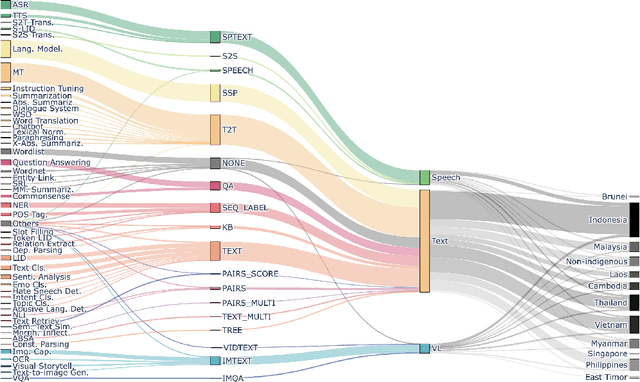
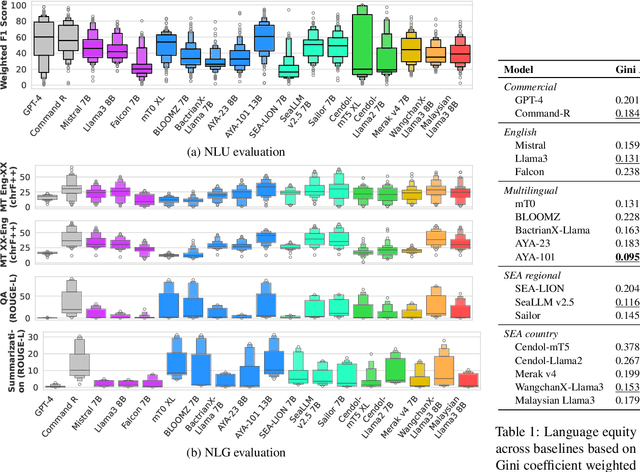
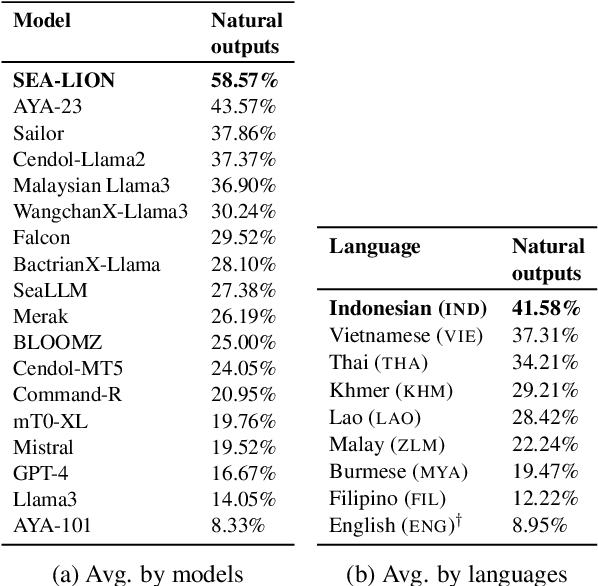
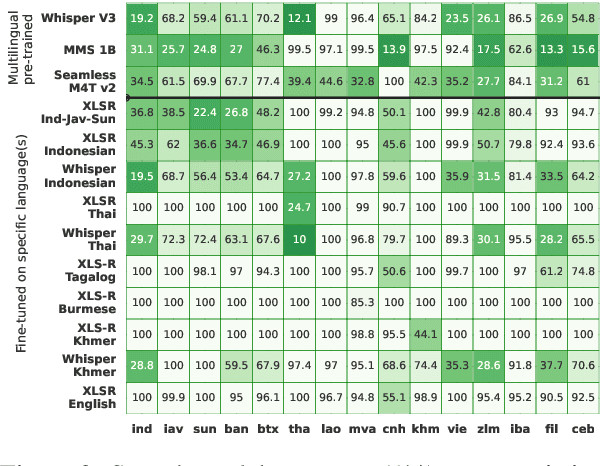
Abstract:Southeast Asia (SEA) is a region rich in linguistic diversity and cultural variety, with over 1,300 indigenous languages and a population of 671 million people. However, prevailing AI models suffer from a significant lack of representation of texts, images, and audio datasets from SEA, compromising the quality of AI models for SEA languages. Evaluating models for SEA languages is challenging due to the scarcity of high-quality datasets, compounded by the dominance of English training data, raising concerns about potential cultural misrepresentation. To address these challenges, we introduce SEACrowd, a collaborative initiative that consolidates a comprehensive resource hub that fills the resource gap by providing standardized corpora in nearly 1,000 SEA languages across three modalities. Through our SEACrowd benchmarks, we assess the quality of AI models on 36 indigenous languages across 13 tasks, offering valuable insights into the current AI landscape in SEA. Furthermore, we propose strategies to facilitate greater AI advancements, maximizing potential utility and resource equity for the future of AI in SEA.
IndoCulture: Exploring Geographically-Influenced Cultural Commonsense Reasoning Across Eleven Indonesian Provinces
Apr 02, 2024Abstract:Although commonsense reasoning is greatly shaped by cultural and geographical factors, previous studies on language models have predominantly centered on English cultures, potentially resulting in an Anglocentric bias. In this paper, we introduce IndoCulture, aimed at understanding the influence of geographical factors on language model reasoning ability, with a specific emphasis on the diverse cultures found within eleven Indonesian provinces. In contrast to prior works that relied on templates (Yin et al., 2022) and online scrapping (Fung et al., 2024), we created IndoCulture by asking local people to manually develop the context and plausible options based on predefined topics. Evaluations of 23 language models reveal several insights: (1) even the best open-source model struggles with an accuracy of 53.2%, (2) models often provide more accurate predictions for specific provinces, such as Bali and West Java, and (3) the inclusion of location contexts enhances performance, especially in larger models like GPT-4, emphasizing the significance of geographical context in commonsense reasoning.
NusaCrowd: Open Source Initiative for Indonesian NLP Resources
Dec 20, 2022Abstract:We present NusaCrowd, a collaborative initiative to collect and unite existing resources for Indonesian languages, including opening access to previously non-public resources. Through this initiative, we have has brought together 137 datasets and 117 standardized data loaders. The quality of the datasets has been assessed manually and automatically, and their effectiveness has been demonstrated in multiple experiments. NusaCrowd's data collection enables the creation of the first zero-shot benchmarks for natural language understanding and generation in Indonesian and its local languages. Furthermore, NusaCrowd brings the creation of the first multilingual automatic speech recognition benchmark in Indonesian and its local languages. Our work is intended to help advance natural language processing research in under-represented languages.
NusaCrowd: A Call for Open and Reproducible NLP Research in Indonesian Languages
Aug 01, 2022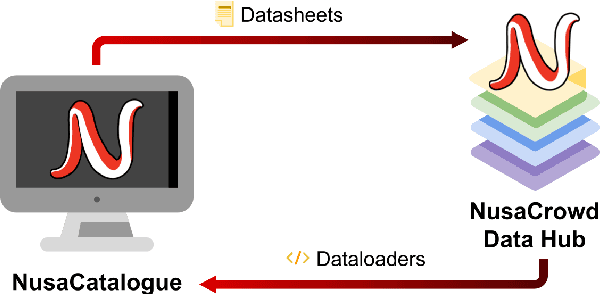

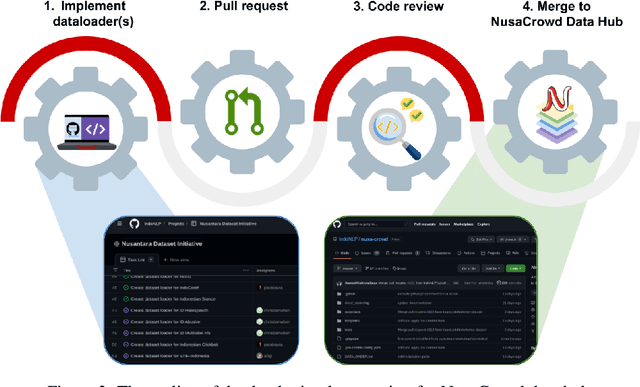
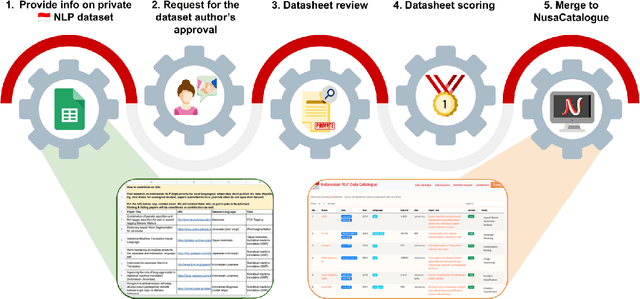
Abstract:At the center of the underlying issues that halt Indonesian natural language processing (NLP) research advancement, we find data scarcity. Resources in Indonesian languages, especially the local ones, are extremely scarce and underrepresented. Many Indonesian researchers do not publish their dataset. Furthermore, the few public datasets that we have are scattered across different platforms, thus makes performing reproducible and data-centric research in Indonesian NLP even more arduous. Rising to this challenge, we initiate the first Indonesian NLP crowdsourcing effort, NusaCrowd. NusaCrowd strives to provide the largest datasheets aggregation with standardized data loading for NLP tasks in all Indonesian languages. By enabling open and centralized access to Indonesian NLP resources, we hope NusaCrowd can tackle the data scarcity problem hindering NLP progress in Indonesia and bring NLP practitioners to move towards collaboration.
Two-Stage Classifier for COVID-19 Misinformation Detection Using BERT: a Study on Indonesian Tweets
Jun 30, 2022



Abstract:The COVID-19 pandemic has caused globally significant impacts since the beginning of 2020. This brought a lot of confusion to society, especially due to the spread of misinformation through social media. Although there were already several studies related to the detection of misinformation in social media data, most studies focused on the English dataset. Research on COVID-19 misinformation detection in Indonesia is still scarce. Therefore, through this research, we collect and annotate datasets for Indonesian and build prediction models for detecting COVID-19 misinformation by considering the tweet's relevance. The dataset construction is carried out by a team of annotators who labeled the relevance and misinformation of the tweet data. In this study, we propose the two-stage classifier model using IndoBERT pre-trained language model for the Tweet misinformation detection task. We also experiment with several other baseline models for text classification. The experimental results show that the combination of the BERT sequence classifier for relevance prediction and Bi-LSTM for misinformation detection outperformed other machine learning models with an accuracy of 87.02%. Overall, the BERT utilization contributes to the higher performance of most prediction models. We release a high-quality COVID-19 misinformation Tweet corpus in the Indonesian language, indicated by the high inter-annotator agreement.
NusaX: Multilingual Parallel Sentiment Dataset for 10 Indonesian Local Languages
May 31, 2022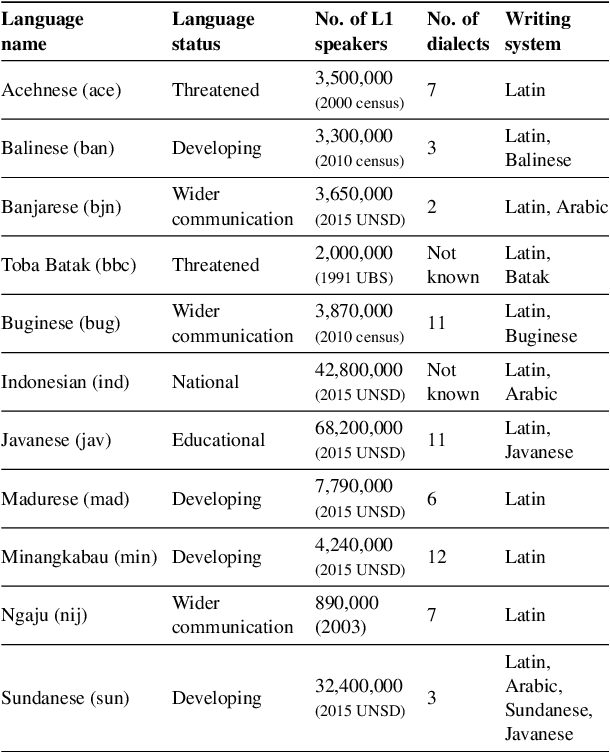
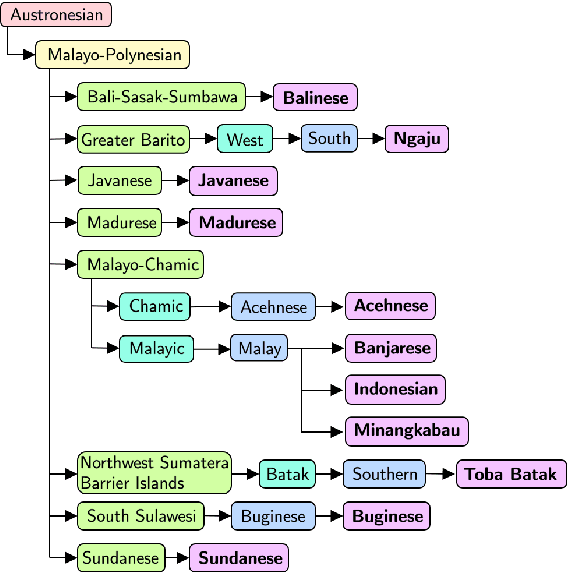
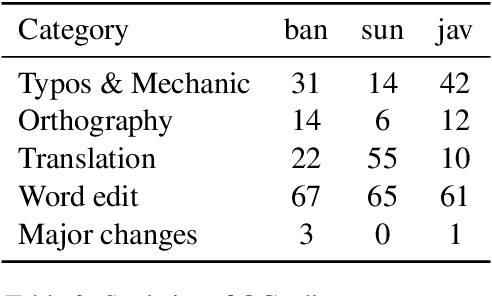
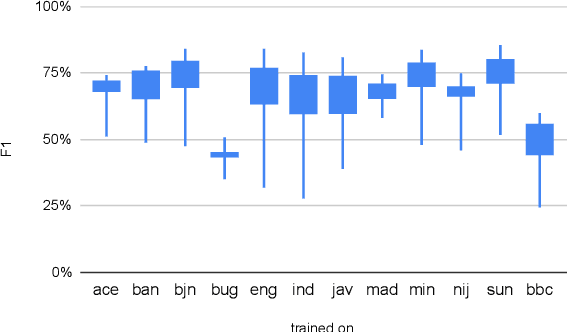
Abstract:Natural language processing (NLP) has a significant impact on society via technologies such as machine translation and search engines. Despite its success, NLP technology is only widely available for high-resource languages such as English and Chinese, while it remains inaccessible to many languages due to the unavailability of data resources and benchmarks. In this work, we focus on developing resources for languages in Indonesia. Despite being the second most linguistically diverse country, most languages in Indonesia are categorized as endangered and some are even extinct. We develop the first-ever parallel resource for 10 low-resource languages in Indonesia. Our resource includes datasets, a multi-task benchmark, and lexicons, as well as a parallel Indonesian-English dataset. We provide extensive analyses and describe the challenges when creating such resources. We hope that our work can spark NLP research on Indonesian and other underrepresented languages.
One Country, 700+ Languages: NLP Challenges for Underrepresented Languages and Dialects in Indonesia
Mar 24, 2022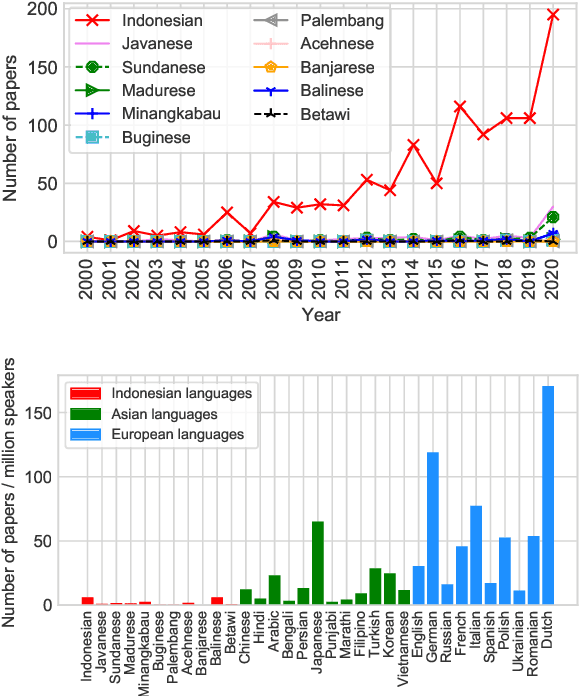
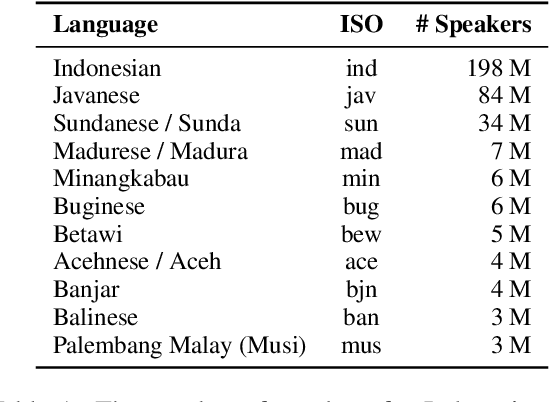


Abstract:NLP research is impeded by a lack of resources and awareness of the challenges presented by underrepresented languages and dialects. Focusing on the languages spoken in Indonesia, the second most linguistically diverse and the fourth most populous nation of the world, we provide an overview of the current state of NLP research for Indonesia's 700+ languages. We highlight challenges in Indonesian NLP and how these affect the performance of current NLP systems. Finally, we provide general recommendations to help develop NLP technology not only for languages of Indonesia but also other underrepresented languages.
ITTC @ TREC 2021 Clinical Trials Track
Feb 16, 2022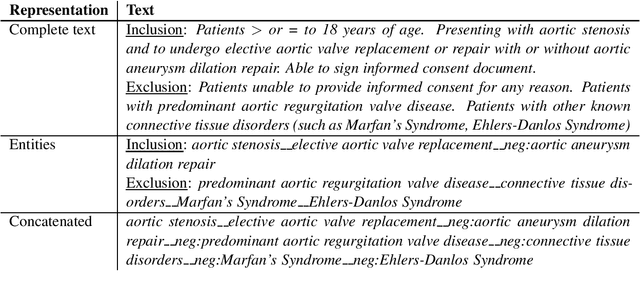

Abstract:This paper describes the submissions of the Natural Language Processing (NLP) team from the Australian Research Council Industrial Transformation Training Centre (ITTC) for Cognitive Computing in Medical Technologies to the TREC 2021 Clinical Trials Track. The task focuses on the problem of matching eligible clinical trials to topics constituting a summary of a patient's admission notes. We explore different ways of representing trials and topics using NLP techniques, and then use a common retrieval model to generate the ranked list of relevant trials for each topic. The results from all our submitted runs are well above the median scores for all topics, but there is still plenty of scope for improvement.
 Add to Chrome
Add to Chrome Add to Firefox
Add to Firefox Add to Edge
Add to Edge